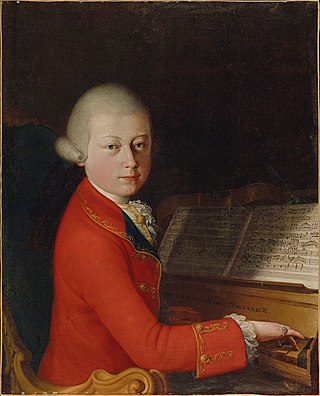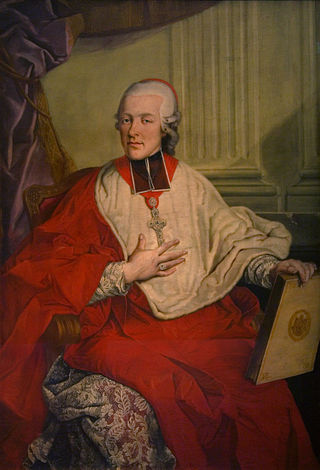
The Piano Sonata No. 13 in B-flat major, K. 333 (315c), also known as the "Linz Sonata", was composed by Wolfgang Amadeus Mozart in Linz at the end of 1783.

Symphony No. 34 in C major, K. 338, was written by Wolfgang Amadeus Mozart in 1780, and completed on 29 August that year.

Symphony No. 6 in F major, K. 43, was composed by Wolfgang Amadeus Mozart in 1767. According to Alfred Einstein in his 1937 revision of the Köchel catalogue, the symphony was probably begun in Vienna and completed in Olomouc, a Moravian city to which the Mozart family fled to escape a Viennese smallpox epidemic; see Mozart and smallpox.

Symphony No. 7 in D major, K. 45, by Wolfgang Amadeus Mozart, was completed in Vienna in January 1768 after the family's return from a visit to Olomouc and Brno in Moravia. The symphony is in four movements. Its first performance was probably at a private concert. The symphony was reworked to become the overture to Mozart's opera, La finta semplice, K. 51, composed and performed later that year, and the overture itself was subsequently adapted further to create a new symphony, known in the Köchel 1964 (K6) catalogue as K. 46a. The autograph of the score is preserved in the Staatsbibliothek Preusischer Kulturbesitz in Berlin.

Symphony No. 12 in G major, K. 110/75b, by Wolfgang Amadeus Mozart, was composed in Salzburg in the summer of 1771. The symphony was apparently prepared in anticipation of Mozart's second Italian journey, which was to take place between August and December 1771. The symphony is in four movements, the opening allegro being the longest movement that Mozart had written to that date. It is the first of a group of works "painted on a larger canvas and achieving a greater individuality than his earlier exuberant pieces".

Symphony No. 13 in F major, K. 112, by Wolfgang Amadeus Mozart, was written in Milan during his second journey to Italy in the autumn of 1771. The symphony is in four movements, the second of which is scored for strings alone. The third movement minuet may have been written earlier, and then incorporated into the symphony—the autograph manuscript shows the minuet copied in Leopold's hand. Nicholas Kenyon describes Symphony No. 13 as the last in "conventional mode"—thereafter "we are in the beginnings of a different world."

Wolfgang Amadeus Mozart wrote Symphony No. 30 in D major, K. 202/186b in Salzburg, completing it on May 5, 1774.

This list of Mozart symphonies of spurious or doubtful authenticity contains 39 symphonic works whose initial attribution to Wolfgang Amadeus Mozart has subsequently been proved spurious, or is the subject of continuing doubt. The number of symphonies actually written by Mozart is imprecisely known; of the 41 formally numbered, three are established as by other composers and another, No. 11, is considered by scholars to be of uncertain authenticity. Outside the accepted sequence 1–41, however, there are around twenty other genuine Mozart symphonies, and beyond these, a larger number of problematic works which have not been authenticated as Mozart's. Some of these may be genuine; dubious works are often treated as authentic by the compilers of collected editions—eight are in the main body of the 1991 Neue Mozart-Ausgabe, and another two are included in the supplementary 2000 volume of works of doubtful authenticity. Some, however, have long been accepted as the works of other composers, who in many instances have been positively identified.

The Missa brevis in G major, K. 140, K3 Anh. 235d, K6 Anh. C 1.12, was probably composed by Wolfgang Amadeus Mozart shortly after returning to Salzburg, in March 1773, from his third trip to Italy.

The Serenade No. 4 in D major, K. 203/189b was written in August 1774 by Wolfgang Amadeus Mozart for ceremonies at the University of Salzburg. It is nicknamed Colloredo after Mozart's patron, Count Hieronymus von Colloredo. The work is very similar to the serenade K. 204 composed for Salzburg the following summer.
The Symphony in F major "No. 42", K. 75, was written by Wolfgang Amadeus Mozart probably around March to August 1771 in Salzburg.

The Symphony in G major "Old Lambach", K. Anh. 221/45a, was probably written by Wolfgang Amadeus Mozart during 1766 in The Hague and revised in 1767. Both versions – the original and the revision – have survived.

The Symphony in F major, K. Anh. 223/19a, was written by Wolfgang Amadeus Mozart probably in early 1765 in London.
The Symphony in B♭ major "No. 55", K. Anh. 214/45b, was probably written by Wolfgang Amadeus Mozart in early 1768 in Salzburg.
The Symphony in D major "No. 45", K. 95/73n, was probably written by Wolfgang Amadeus Mozart in 1770 in Rome.
The Symphony in D major "No. 47", K. 97/73m, was probably written by Wolfgang Amadeus Mozart in 1770 in Rome.
The Symphony in F major "No. 56", K. 98/Anh.C 11.04, was once thought to have been written by Wolfgang Amadeus Mozart, but today is regarded as spurious. As of 2009, it is the only one of Mozart's symphonies published in the Alte Mozart-Ausgabe that has never been recorded. It is not included in the Neue Mozart-Ausgabe.
The Symphony in D major "No. 44", K. 81/73l, may have been written by Wolfgang Amadeus Mozart in 1770 in Rome, although it has sometimes also been attributed to his father Leopold Mozart. It is now also catalogued as Eisen D 14 in Cliff Eisen's catalogue of Leopold Mozart's symphonies.
The Symphony in B♭ major "No. 54", K. Anh. 216/74g/Anh.C 11.03, may have been written by Wolfgang Amadeus Mozart in 1771, in Salzburg.

The Symphony in A minor "Odense", K. Anh. 220/16a, was formerly attributed to Wolfgang Amadeus Mozart. If the Odense Symphony had truly been Mozart's, it would be among only three of Mozart's symphonies to be written in a minor key. It is now considered certain that the symphony is not by Mozart.





